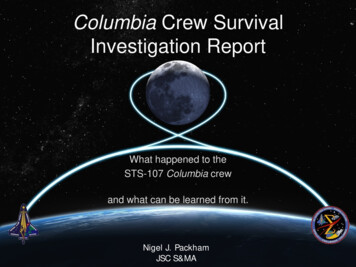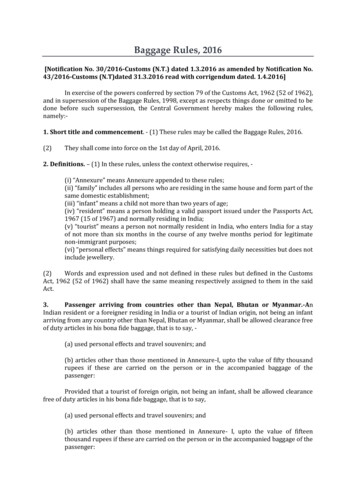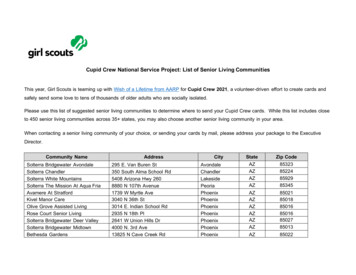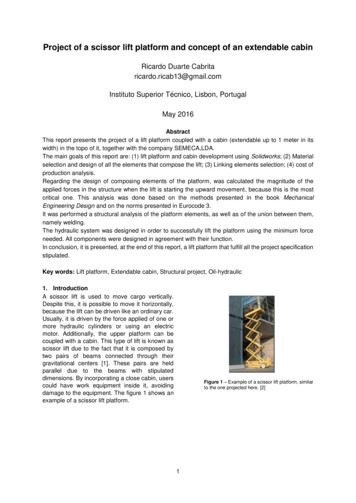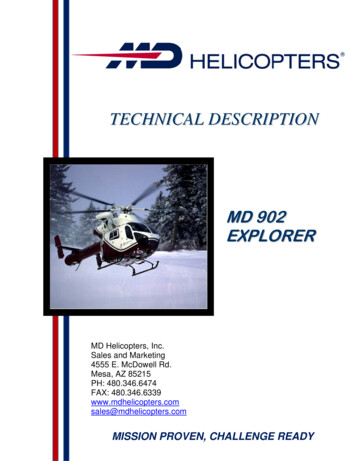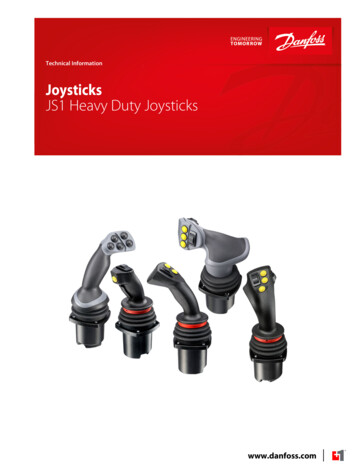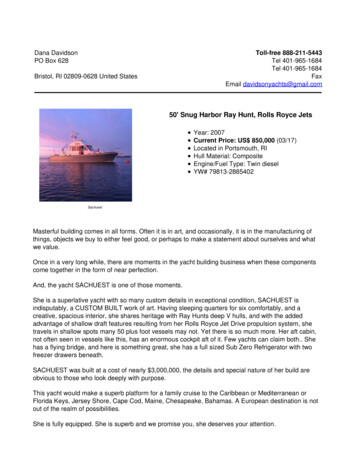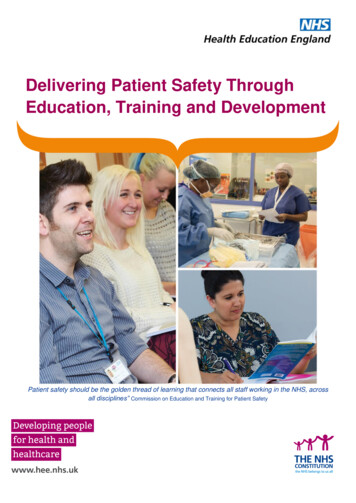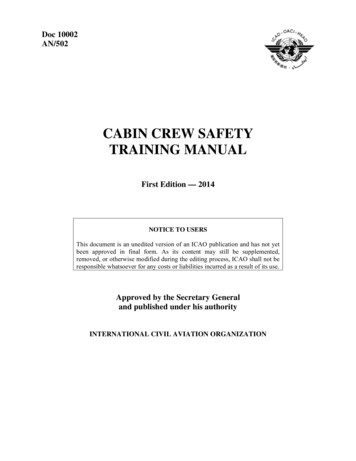
Transcription
Doc 10002AN/502CABIN CREW SAFETYTRAINING MANUALFirst Edition — 2014NOTICE TO USERSThis document is an unedited version of an ICAO publication and has not yetbeen approved in final form. As its content may still be supplemented,removed, or otherwise modified during the editing process, ICAO shall not beresponsible whatsoever for any costs or liabilities incurred as a result of its use.Approved by the Secretary Generaland published under his authorityINTERNATIONAL CIVIL AVIATION ORGANIZATION
AMENDMENTSAmendments are announced in the supplements to the Catalogue of ICAO Publications; the Catalogueand its supplements are available on the ICAO website at www.icao.int. The space below is provided tokeep a record of such amendments.RECORD OF AMENDMENTS AND CORRIGENDANo.AMENDMENTSDateEntered byNo.iCORRIGENDADateEntered by
FOREWORDCabin safety contributes to the prevention of accidents and incidents, protection of the aircraft’soccupants, through proactive safety management, including hazard identification, safety risk managementand the increase of survivability in the event of an emergency situation. Traditionally, the role of cabincrew members focused on the evacuation of an aircraft in the event of an accident. However, cabin crewmembers also play an important proactive role in managing safety, which can contribute to the preventionof incidents and accidents. Training is necessary to prepare cabin crew members to conduct their safetyrelated duties and responsibilities during normal day-to-day flights and essential to enable them torecognize and act on any abnormal or emergency situation.The ICAO Cabin Crew Safety Training Manual (Doc 10002) provides guidance related to cabin crewtraining requirements found in Annex 6 — Operation of Aircraft, Part I — International Commercial AirTransport — Aeroplanes.ICAO developed guidance for a competency-based approach to cabin crew safety training so thatcabin crew members may be proficient to perform their duties and responsibilities, and with the goal ofestablishing an international baseline for cabin crew competencies. The manual presents cabin crew safetytraining using a competency-based approach. It provides guidance for operators to develop cabin crewcompetency-based training.The content of this manual is adaptable and operators should tailor it to suit their operation. It is alsoprovided as guidance for States when approving a training programme. However, the content does notrepresent the sole means to meet regulatory requirements on cabin crew training. The training syllabus ofcabin crew members assigned for duties on commercial international air transport operations shouldinclude all relevant parts of the syllabuses suggested in this manual but should not be limited by it. Thisdocument replaces ICAO Cabin Attendants’ Safety Training Manual (Doc 7192, Part E-1, Second Edition,1996).The content of this manual was developed over a period of two years with inputs from experts fromcivil aviation authorities, airlines, aircraft manufacturers, training organizations, airline and cabin crewrepresentative organizations, aviation medicine and human performance specialists; and was thereaftersubmitted for an extensive peer review to collect and take into account comments from the expertcommunity.ICAO gratefully acknowledges the contribution received from the ICAO Cabin Safety Group, as wellas the IATA Medical Advisory Group, members of the ICAO Medical Provisions Study Group, andindividual experts who have provided support, advice and input for this manual.ii
ACKNOWLEDGEMENTSICAO gratefully acknowledges contributions from the following:Air CanadaFederal Aviation AdministrationAir Canada RougeFlight Attendant School r FranceGOL Linhas Aéreas InteligentesAir New ZealandInternational Air Transport AssociationAir TransatInternational Transport Workers’ FederationAirbusJamaica Civil Aviation AuthorityAlitalia – Compagnia Aerea ItalianaJetstar AirwaysAmerican AirlinesKenya AirwaysAvianca AirlinesKLM Royal Dutch AirlinesBoeing CompanyLufthansa German AirlinesBritish AirwaysNational Civil Aviation Agency of BrazilCalm Air InternationalProvincial AirlinesCathay Pacific AirwaysSaudia AirlinesCentral American Agency for Aviation SafetySingapore AirlinesCivil Aviation Authority of IsraelSky Regional AirlinesCivil Aviation Authority of New ZealandSouth Africa Civil Aviation AuthorityCivil Aviation Authority of SingaporeTransport Canada Civil AviationCivil Aviation Safety Authority of AustraliaUAE General Civil Aviation AuthorityCondor FlugdienstUK Civil Aviation AuthorityEmirates AirlineUnited AirlinesEuropean Aviation Safety AgencyFederal Air Transport Agency (Rosaviatsia)iii
TABLE OF CONTENTSForeword. iiAcknowledgement. iiiList of Acronyms. viiiDefinitions. 1Chapter 1: Cabin crew safety training requirements and qualifications . ew of cabin safety and the role of cabin crew . 8Cabin crew safety training . 8ICAO Standards and Recommended Practices (SARPs) . 9Recommended minimum qualifications . 10Types of training . 11Initial training . 11Aircraft type training . 12Differences training . 13Aircraft visit . 13Familiarization flight . 14Recurrent training . 14Requalification programmes . 15Specific training methods . 16Appendix 1 to Chapter 1: Examples of requalification programmes . 17Appendix 2 to Chapter 1: Advance qualification programme . 20Appendix 3 to Chapter 1: Transferable training examples . 21Appendix 4 to Chapter 1: Training programmes for use by multiple operators . 22Appendix 5 to Chapter 1: Group line indoctrination training . 23Appendix 6 to Chapter 1: European approach on aircraft type training . 25Chapter 2: Training facilities and devices . 272.12.22.32.42.52.62.72.82.9Facilities and equipment for classroom-based training . 27Trainee to instructor ratio . 28Representative training devices . 29Safety and emergency equipment. 29Cabin training devices . 30Emergency exit trainer . 32Fire-fighting . 33Water survival . 33Use of other operator or ATO training devices . 33Chapter 3: Competency-based approach to cabin crew safety training . 343.13.23.33.43.5Understanding competency-based training programmes . 34Benefits of competency-based training . 34Development of competency framework . 35Breakdown of the framework components. 36Structure of the chapters for competency-based training . 37iv
Chapter 4: Aviation indoctrination training . 394.14.24.34.44.54.6Definition and goal of aviation indoctrination training . 39Content of aviation indoctrination training . 39Applicable regulations . 39Aviation terminology . 40Theory of flight and aircraft operations. 41Altitude physiology . 42Chapter 5: Normal operations training . n and goal of normal operations training . 44Content of normal operations training . 44Hands-on exercises and simulated exercises . 45Competency-based training for normal operations . 45Competency Unit 1 – Perform duties and responsibilitiesduring ground and pre-flight operations . 45Competency Unit 2 – Perform duties and responsibilities during pushback and taxi . 56Competency Unit 3 – Perform duties and responsibilities during take-off . 61Competency Unit 4 – Perform duties and responsibilities during climb . 63Competency Unit 5 – Perform duties and responsibilities during cruise . 64Competency Unit 6 – Perform duties and responsibilities during descent and approach. 71Competency Unit 7 – Perform duties and responsibilities during landing . 75Competency Unit 8 – Perform duties and responsibilities during . 77post-landing and post-flight operationsAppendix 1 to Chapter 5. Competency framework for cabin crew member’s duties andresponsibilities during normal operations. 84Chapter 6. Abnormal and emergency situations training . efinition of goal of abnormal and emergency situations training . 91Content of abnormal and emergency situations training . 91Hands-on exercises and simulated exercises . 91Competency-based training for abnormal and emergency situations . 92Fire-fighting . 93Smoke removal procedures . 97Cabin pressurization problems and decompression. 100Anticipated emergency landing/ditching . 102Unanticipated emergency landing/ditching . 106Evacuation . 108Flight crew incapacitation . 113Cabin crew incapacitation . 115Single cabin crew member incapacitation . 116Rapid disembarkation . 117Appendix 1 to Chapter 6. Competency framework for cabin crew member’s dutiesand responsibilities during abnormal and emergency situations . 119v
Chapter 7. Dangerous goods training . 1237.17.27.37.47.5Definition and goal of dangerous goods training . 123Content of dangerous goods training . 124Competency-based training related to dangerous goods . 124Competency Unit 1 – Perform duties and responsibilities related tothe safe transport of permitted dangerous goods in the cabin . 124Competency Unit 2 – Perform duties and responsibilitiesrelated to dangerous goods incidents during flight. 129Appendix 1 to Chapter 7. Competency framework for cabin crewmember’s duties and responsibilities related to dangerous goods . 135Chapter 8. Human performance training . 1388.18.28.38.48.58.68.78.88.9Definition and goal of human performance training . 138Content of human performance training. 138Hands-on exercises and simulated exercises . 139Human factors in aviation . 139Human error . 140Cabin crew skills . 141Crew resource management (CRM) . 141Threat and error management. 143Case studies . 144Appendix 1 to Chapter 8.Cabin crew skills and behavioural indicators. 145Chapter 9. Cabin health and first aid training . 1519.19.29.39.49.59.69.79.8Introduction . 151Contents of cabin health and first aid training. 151Hands-on exercises and simulated exercises . 152Competency-based training for cabin health and first aid . 152Management of on-board medical events. 152Food safety and sanitation . 157Cabin disinsection . 159Potential aviation-associated health risks . 160Appendix 1 to Chapter 9. Competency framework for cabin crew member’s duties andresponsibilities related to cabin health and first aid . 162Chapter 10. Aviation security training . 16310.110.210.310.410.510.610.710.810.9Definition and goal of aviation security training . 163Content of aviation security training . 163Preventive measures . 164Security of the flight deck . 164Competency-based training for security threat situations . 164Unruly passengers . 165Bomb threat or bomb on-board in flight. 167Bomb threat or bomb on-board on the ground . 169Hijacking . 170vi
10.10Chemical/biological/radiological weapons . 172Appendix 1 to Chapter 10. Competency framework for cabin crew member’sduties and responsibilities related to security threat situations. 174Chapter 11. Safety management system (SMS) training . 17611.111.211.311.411.511.6Definition and goal of SMS training . 176Content of SMS training. 176SMS fundamentals and overview of the operator’s SMS. 177The organization’s safety policy . 177Hazard identification and reporting . 178Safety communication . 180Chapter 12. Fatigue management training . 18212.112.212.312.412.5Definition and goal of fatigue management training . 182Content of fatigue management training . 182Prescriptive fatigue management for cabin crew . 183Fatigue risk management systems (FRMS) for cabin crew . 186Recurrent fatigue management training . 190Chapter 13. In-charge cabin crew member training . 3.12Definition and goal of in-charge cabin crew member training . 191Competency-based training for in-charge cabin crew member . 191Content of in-charge cabin crew member training . 192Briefings . 192Communication, cooperation and coordinationwithin the crew and with other personnel. 192Operator’s procedures and legal requirements . 193Administrative tasks required by the operator. 193Human performance . 193Reporting systems and requirements . 194Fatigue management. 194Leadership skills . 194In-charge cabin crew member recurrent training . 195Chapter 14. Management aspects of the cabin safety training programme . 19614.114.214.314.414.514.614.714.814.9Overview . 196Cabin crew safety training manager . 196Cabin crew instructor . 197Cabin crew examiner . 198Training programme developer . 199Training delivery methods. 199Examiner reliability . 200Continuous improvement of the training programme . 200Documentation . 201Appendix 1 to Chapter 14. Competency frameworks for cabin crew instructors,cabin crew examiners and training programme developers . 203vii
LIST OF DSARPsSMSSSPSTCTCCATEMUTCAdvisory circularAir operator certificateAdvanced qualification programmeApproved training organizationCommercial air service based trainingCardiopulmonary resuscitationCrew resource managementCabin training devicesEuropean Aviation Safety AgencyEmergency locator transmitterAutomatic-fixed ELTAutomatic-deployable ELTSurvival ELTEuropean UnionFederal Aviation AdministrationFatigue risk management systemIn-charge cabin crew memberInstructional systems designLearning management systemMinimum equipment listMaster minimum equipment listOperational suitability dataProtective breathing equipmentPerformance criteriaPersonal electronic deviceStandards and Recommended PracticesSafety management systemState safety programmeSupplemental type certificateTransport Canada Civil AviationThreat and error managementCoordinated universal time———————————viii
Cabin Crew Safety Training Manual (Doc 10002)1DEFINITIONSAble-bodied passengers. Passengers who are clearly physically able and are willing to help cabin crewmaintain good order and discipline on-board the aircraft.Accountable executive. A single, identifiable person having responsibility for the effective and efficientperformance of the State’s safety programme (SSP) or of the service provider’s safety managementsystems (SMS).Air operator certificate (AOC). A certificate authorizing an operator to carry out specified commercial airtransport operations.Aircraft. Any machine that can derive support in the atmosphere from the reactions of the air other thanthe reactions of the air against the earth’s surface.Airworthy. The status of an aircraft, engine, propeller or part when it conforms to its approved design andis in a condition for safe operationApproved training organization — Cabin crew. An organization approved by a Contracting State inaccordance with the national regulations to perform cabin crew training and which operates under thesupervision of that State.Approved training — Cabin crew. Training conducted under special curricula and supervision approvedby a Contracting State that, where applicable, is conducted within an approved training organization.Attendant panel. Control panel(s) intended for use by cabin crew to operate and/or monitor aircraftsystems relevant to cabin crew duties during normal operations and in the event of emergencysituations.Baggage. Personal property of passengers or crew carried on an aircraft by agreement with the operator.Barostatic. An atmospheric pressure, used in forecasting the weather and determining altitude, derivedusing a barometer.Cabin crew member. A crew member who performs, in the interest of safety of passengers, dutiesassigned by the operator or the pilot-in-command of the aircraft, but who shall not act as a flight crewmember.Change management. A formal process to manage changes within an organization in a systematicmanner, so that changes which may impact identified hazards and risk mitigation strategies areaccounted for, before the implementation of such changes.Classroom training. In-person, instructor-led training which may include group exercises and interactiveinstructional sessions.Clean aircraft concept. All critical surfaces of an aircraft must be clean of any surface contamination.The critical surfaces of an aircraft are the wings, control surfaces, rotors, propellers, horizontalstabilizers, vertical stabilizers or any other stabilizing surface. In the case of an aircraft with rearmounted engines, the upper surface of the fuselage is also a critical surface.Clear zone. The area of the passenger cabin immediately in front of the flight crew compartment door,including galleys and lavatories.
2Cabin Crew Safety Training Manual (Doc 10002)Cognitive. Pertaining to cognition. Knowing, perceiving, or conceiving as an act or faculty distinct fromemotion and volition.Colicky pain. Denoting or resembling the pain of colic: pain relating to the colon. Spasmodic pains in theabdomen caused by spasm, obstruction or twisting.Competency element. An action that constitutes a task that has a triggering event and a terminating eventthat clearly defines its limits, and an observable outcome.Competency unit. A discrete function consisting of a number of competency elements.Competency. A combination of skills, knowledge and attitudes required to perform a task to theprescribed standard.Co-pilot. A licensed pilot serving in any piloting capacity other than as pilot-in-command but excluding apilot who is on board the aircraft for the sole purpose of receiving flight instruction.Computer-based training. Training involving instructional aids, such as computers and tablets.Compu
TRAINING MANUAL First Edition — 2014 NOTICE TO USERS This document is an unedited version of an ICAO publication and has not yet been approved in final form. As its content may still be supplemented, removed, or otherwi
